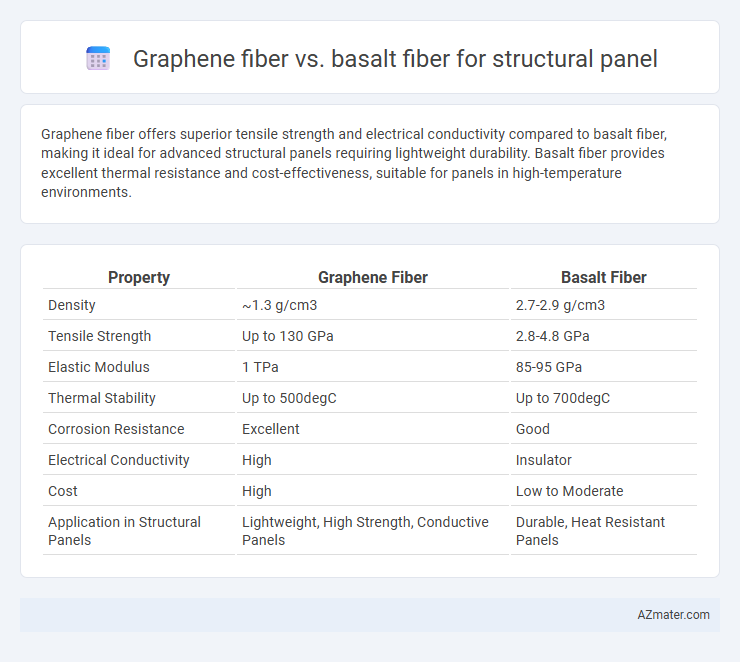Graphene fiber offers superior tensile strength and electrical conductivity compared to basalt fiber, making it ideal for advanced structural panels requiring lightweight durability. Basalt fiber provides excellent thermal resistance and cost-effectiveness, suitable for panels in high-temperature environments.
Table of Comparison
| Property | Graphene Fiber | Basalt Fiber |
|---|---|---|
| Density | ~1.3 g/cm3 | 2.7-2.9 g/cm3 |
| Tensile Strength | Up to 130 GPa | 2.8-4.8 GPa |
| Elastic Modulus | 1 TPa | 85-95 GPa |
| Thermal Stability | Up to 500degC | Up to 700degC |
| Corrosion Resistance | Excellent | Good |
| Electrical Conductivity | High | Insulator |
| Cost | High | Low to Moderate |
| Application in Structural Panels | Lightweight, High Strength, Conductive Panels | Durable, Heat Resistant Panels |
Introduction to Graphene Fiber and Basalt Fiber
Graphene fiber is a high-strength, lightweight material composed of carbon atoms arranged in a hexagonal lattice, offering exceptional tensile strength, electrical conductivity, and thermal stability for advanced structural panels. Basalt fiber is derived from volcanic basalt rock, providing excellent durability, fire resistance, and chemical stability, with mechanical properties that rival traditional glass fibers in structural applications. Both materials present innovative solutions for enhancing structural panel performance, with graphene fiber excelling in strength-to-weight ratio and basalt fiber delivering cost-effective, eco-friendly reinforcement.
Material Composition and Manufacturing Processes
Graphene fiber comprises carbon atoms arranged in a hexagonal lattice, offering exceptional tensile strength and electrical conductivity, while basalt fiber is produced by melting basalt rock and extruding it into fine fibers with high thermal and chemical resistance. Manufacturing graphene fiber involves chemical vapor deposition (CVD) or exfoliation methods to achieve nanoscale thickness and purity, whereas basalt fiber production uses high-temperature melting and fiberizing techniques similar to glass fiber processes. Graphene fiber's advanced molecular structure provides superior mechanical properties and flexibility compared to the more abundant and cost-effective basalt fiber, which excels in durability and environmental resistance for structural panel applications.
Mechanical Strength and Performance Comparison
Graphene fiber exhibits superior tensile strength and elasticity compared to basalt fiber, making it highly effective in enhancing the mechanical performance of structural panels. Basalt fiber offers good compressive strength and excellent thermal resistance but falls short in tensile strength relative to graphene fiber. The integration of graphene fiber results in panels with increased durability, flexibility, and load-bearing capacity, outperforming basalt fiber in critical structural applications.
Weight and Density Differences
Graphene fiber exhibits significantly lower density, typically around 1.3-1.4 g/cm3, compared to basalt fiber's density of approximately 2.7-3.0 g/cm3, contributing to lighter structural panels when used as reinforcement. The reduced weight of graphene fiber panels enhances ease of installation and improves overall structural efficiency by minimizing load demands. Despite its lower density, graphene fiber maintains high mechanical strength, making it an ideal choice for lightweight, high-performance structural panel applications.
Thermal and Electrical Conductivity
Graphene fiber exhibits exceptional thermal conductivity, reaching up to 5000 W/m*K, significantly outperforming basalt fiber, which typically ranges around 1.5 W/m*K, making graphene fiber ideal for applications requiring efficient heat dissipation in structural panels. In terms of electrical conductivity, graphene fiber demonstrates excellent conductivity due to its high electron mobility, whereas basalt fiber is an electrical insulator, limiting its use in conductive applications. The superior thermal and electrical properties of graphene fiber contribute to enhanced performance and multifunctionality in advanced structural panel designs.
Durability and Environmental Resistance
Graphene fiber offers superior durability with exceptional tensile strength and resistance to degradation under UV exposure and moisture, making it highly suitable for structural panels in harsh environmental conditions. Basalt fiber, while durable and corrosion-resistant, tends to have lower impact resistance and can degrade faster when exposed to alkaline environments compared to graphene fiber. The enhanced chemical stability and mechanical properties of graphene fiber translate into longer service life and reduced maintenance for structural panels in demanding applications.
Cost Analysis and Market Availability
Graphene fiber offers superior tensile strength and lightweight properties compared to basalt fiber but comes at a significantly higher cost, limiting its widespread use in structural panel applications. Basalt fiber, derived from volcanic rock, provides a more cost-effective and readily available option with good durability and thermal resistance, making it a popular choice in construction markets. Market availability for basalt fiber is well-established globally, whereas graphene fiber remains niche with limited suppliers and higher production expenses impacting large-scale adoption.
Sustainability and Environmental Impact
Graphene fiber offers superior sustainability compared to basalt fiber due to its lightweight nature, which reduces material consumption and lowers carbon emissions during transportation and installation. Basalt fiber, sourced from abundant volcanic rock, provides eco-friendly raw material options but involves energy-intensive melting processes, increasing its environmental footprint. Both fibers enhance structural panel durability, but graphene fiber's potential for recycling and longer lifespan contributes to reduced environmental impact over the product lifecycle.
Applications in Structural Panels
Graphene fiber exhibits exceptional tensile strength and electrical conductivity, making it ideal for advanced structural panels in aerospace and automotive industries where lightweight and high-performance materials are critical. Basalt fiber offers superior thermal resistance and cost-effectiveness, commonly used in building facades and infrastructure panels requiring enhanced durability and fire resistance. Structural panels utilizing graphene fiber provide improved impact resistance and flexibility, while basalt fiber panels excel in environmental sustainability and corrosion resistance, broadening their application spectrum in construction.
Future Prospects and Technological Innovations
Graphene fiber exhibits superior tensile strength, electrical conductivity, and lightweight properties compared to basalt fiber, making it a promising material for advanced structural panels in aerospace and automotive industries. Innovations in graphene fiber production, such as scalable chemical vapor deposition and enhanced functionalization techniques, are driving its future adoption by overcoming previous cost and manufacturing barriers. Basalt fiber remains valuable due to its thermal stability and corrosion resistance, but ongoing R&D in graphene composites aims to surpass these advantages, positioning graphene fiber as the next-generation reinforcement for high-performance structural applications.

Infographic: Graphene fiber vs Basalt fiber for Structural panel
 azmater.com
azmater.com